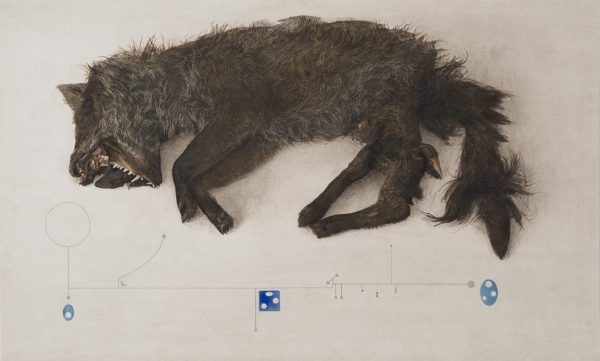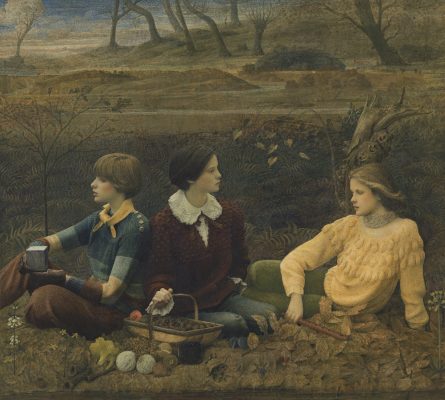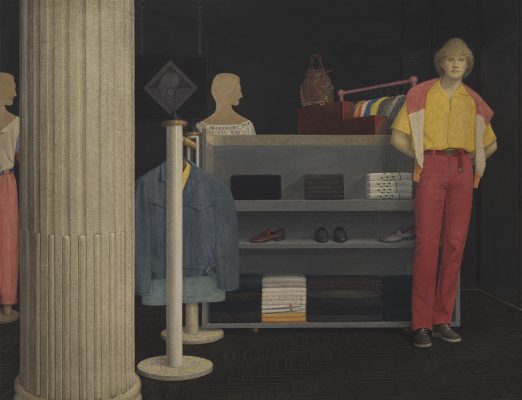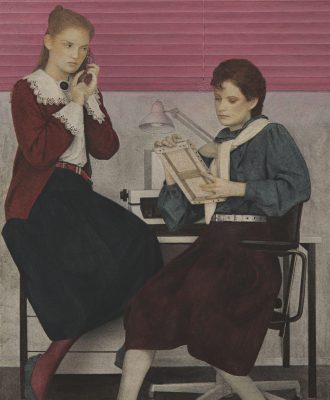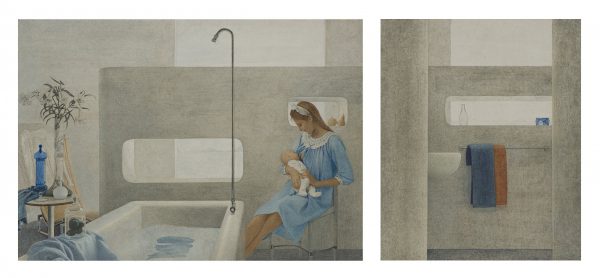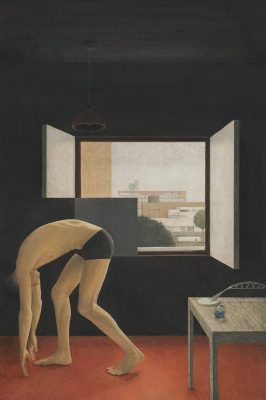The woman in Graham Little’s Untitled (Mother and Baby) (2019) sits in a bathroom of stone curves and oblong cavities. Behind her the view is impeccable: the sea a nacreous blend that accumulates in the sky, save frail crests of distant mountains. Pull back, and the room is sterile and tepid. A tall Emile Gallé vase hosts white lilies, a plump hobnail glass bottle rests beside a peacock blue decanter. Think patchouli, invoke mimosa. The bath is drawn; the water waits. The shower pipe of chrome tips its heron-esque neck. Smiling in her kingfisher blue gown she cradles her clothed babe, her nipple, untouched, only just bare enough for suckling.
Little’s immaculate and labour intensive works, on show at Alison Jacques Gallery, take months to complete. Each composition emanates a weird, soporific ache. Little says of his paintings of women: ‘for a while I can be the woman in that world … I think that’s why they’re all so well honed; I completely immerse myself in that dream.’ Undoubtedly, it is a specific kind of woman in a specific world: as perfected and marvelled at as a Fabergé egg. This dream evolved during his upbringing in Dundee, when the ravishing chiffons, innocuous gazes and orchidaceous faces of fashion photography enraptured his mind. Around 2000, he began rendering photographs from pages of Vogue, Harper’s Bazaar, and mid-1970-80s issues of Burda Moden, first in pencil and later in a mix of pencil and gouache. Since then, Little’s paintings have matured into their own independent realities, though they retain the nostalgic style of pre-Raphaelite daze and editorial torpor. Distinct as lockets yet seductive as voids, all are masterly examples of perfumed paralysis.
In Untitled (Wood) (2019), three young women lounge in grass near a fern-strewn wood. Here, time is modulated. Each figure belongs to their own era, shown in profile so their alternate perspectives never meet. The girl on the right in a 1970s buttercup knit holds a recorder, in allusion to folk traditions popular during the period. The middle girl clasps her basket of reaped possessions: conkers, blackberries, heaps of hazelnuts, navy and red mushrooms. The figure on the left looks more late 1980s, her blusher stronger, her lips tinted. She cradles a metal cube, telltale of nascent technology’s shimmering possibility.
Coloured pencil leaves soft strokes. The lone woman in Untitled (Veranda) (2016) wears a guava pink pinafore, the room she is in as fresh as the laundered shirt she lifts from a canary yellow tub. This composition is intimist in nature, redolent of the interior scenes of Pierre Bonnard and Édouard Vuillard, and the genre paintings of Johannes Vermeer and Jean-Baptiste-Siméon Chardin who inspired them. Open black wooden shutters reveal a landscape of greys and clipped trees. Though she is absorbed in quietude something attracts her eye; she turns her neck as though aware of something outside. Whether she is momentarily arrested by alarm or beauty, we will never know. Here, minutiae are portentous, invoking a diaphanous sense of dread.
The paintings at Alison Jacques are uniformly inset within a wide border of pale beige cloth. This cauterises the boundaries of each work’s respective environment – rarely does a glance meet another – protecting the beautifully constructed delusion. The level of detail, absorption and intensity in Little’s paintings amounts to a kind of effacing self-portrait. Identity can just as much crystallise through others: the way we vicariously consume their gestures and inflections, their auras. In the morning scene Untitled (2018), a room of low, bent chrome furniture mingles with minimalist painting; a young man in loungewear, perhaps Bottega Veneta, sips an espresso, his cheek mimicking an infant nursing. A bowl of unblemished plums and a gargantuan domed lamp discretely undermine the skinny, prickly cactus in the foreground, planted in a lumpy Giorgio Morandi-style pot. Little does not seem concerned with looking-as-possession – there is no sense of open availability here. Instead, his paintings read as wary of attraction. In his scrutiny comes dismay. The figures in his paintings evade human engagement, as though such intimacies could only wound. Their inert dispositions adhere to glamour’s silent principle: lack. Disinterested in Little, the viewer, or the world in which he has situated them, only objects hold their attention. Perhaps because of this, despite their serene neutrality, Little’s paintings are stained with pain.
Only in Untitled (Telephone) (2019) does one figure look directly at another, and yet both are tethered to objects. While on the telephone, a young woman observes her colleague with a look of concern and denigration. The recipient of her gaze is listlessly viewing a petite canvas that she holds in her hands. Her handling suggests possession, but her eyes appear dimmed of fascination, as if she has fallen out of love with it.
In Untitled (Fox) (2017), pain and putrefaction are in focus: a rotting fox with a wiry coat, fractured legs and clobbered jaw. A horizontal line appears to scale the carcass; strange detectors of futurist blue shapes create destinations between nodal points. The fox becomes an object that the hand will index, as though to become immune to decay, to beauty, or the morass of emotion, one must master measurement.
share
ABOUT THE CONTRIBUTOR
Alex Bennett
is a writer and editor based in London. He is co-editor of Tinted Window, features editor of Novembre, and a UK correspondent of Flash Art.
